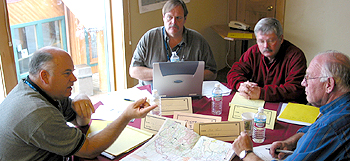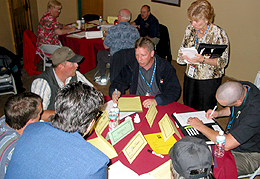
|
CONNECTIONS
|
IDAHO
ITD
HOME
IDAHO DMV
ITD NEWS
HIGHWAY
SAFETY
IDAHO STATE
POLICE
TRAVEL SERVICES
STATE OF IDAHO
NATIONAL
AASHTO
AAMVA
AAA of IDAHO
FEDERAL HIGHWAYS
FEDERAL AVIATION
IDAHO STATE POLICE
NHTSA
NTSB
TRB
U.S. DOT
Idaho
Transportation
Department
Public Affairs Office
P.O. Box 7129
Boise, ID 83707
208.334.8005
Fax: 208.334.8563
Email


Scenario tests transportation agencies' responses
to fabricated earthquakes, volcano eruption
What would you do?
A simulated earthquake with a magnitude of 7.3 strikes southeast Idaho, northern Utah and southwest Wyoming at 8:40 a.m. The epicenter is just east of Bear Lake near the Idaho/Utah border. Less than 30 minutes later, Newberry Crater in central Oregon comes to life in an 8:05 a.m. (PDT) fictitious eruption that sends ash plumes 85,000 feet into the air and drifts northeast across Oregon into Washington.
 Before
the dust settles, according to the fabricated scenario, an aftershock
with a magnitude of 7.1 rocks the northern areas of the earlier quake.
The 12:53 p.m. (MDT) sequel is centered about two miles northeast of
Afton, Wyo.
Before
the dust settles, according to the fabricated scenario, an aftershock
with a magnitude of 7.1 rocks the northern areas of the earlier quake.
The 12:53 p.m. (MDT) sequel is centered about two miles northeast of
Afton, Wyo.
Participants met this week at Grand Targhee Resort west of Driggs to map out a strategy of coping with a potential regional disaster. Six state transportation departments (Idaho, Montana, Oregon, Washington, Utah, Wyoming) and a number of federal agencies were involved in the training exercise, including:
The U.S. Geological Survey, the Federal Emergency Management Agency, Department of Homeland Security, Federal Highway Administration, Department of the Interior (National Park Service), U.S. Coast Guard, and Transport Canada.
It was all part of Cascade Fury II, sponsored by the U.S. Department of Transportation, FEMA and the Idaho Transportation Department. The joint emergency transportation exercise drew approximately 130 participants from throughout the Northwest and federal representatives from Washington, D.C.
 Nearly
one-third of the participants represented ITD, including director Dave
Ekern – who provided opening remarks Tuesday and District 1 Engineer
L. Scott Stokes. Most of ITD’s districts and Headquarters joined
in the emergency planning process.
Nearly
one-third of the participants represented ITD, including director Dave
Ekern – who provided opening remarks Tuesday and District 1 Engineer
L. Scott Stokes. Most of ITD’s districts and Headquarters joined
in the emergency planning process.
Like generals in a war room, transportation officials planned a strategy to deploy personnel and equipment, protect infrastructures, close hazardous routes and assist with life/safety issues. It required regional cooperation and collaboration along a number of transportation fronts, including highways, rail and air.
The purpose of the exercise, according to organizers,
was to build partnerships and promote teamwork for regional transportation
emergencies, to focus on relationships among states, federal government
and private industry, and to use a number of information products.
| TRANSPORTER HOME | MILESTONES | ARCHIVES |